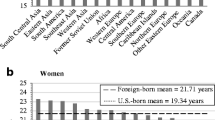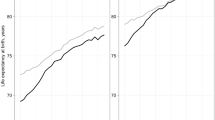Abstract
Studies consistently document a Hispanic paradox in U.S. adult mortality, whereby Hispanics have similar or lower mortality rates than non-Hispanic whites despite lower socioeconomic status. This study extends this line of inquiry to disability, especially among foreign-born Hispanics, since their advantaged mortality seemingly should be paired with health advantages more generally. We also assess whether the paradox extends to U.S.-born Hispanics to evaluate the effect of nativity. We calculate multistate life tables of life expectancy with disability to assess whether racial/ethnic and nativity differences in the length of disability-free life parallel differences in overall life expectancy. Our results document a Hispanic paradox in mortality for foreign-born and U.S.-born Hispanics. However, Hispanics’ low mortality rates are not matched by low disability rates. Their disability rates are substantially higher than those of non-Hispanic whites and generally similar to those of non-Hispanic blacks. The result is a protracted period of disabled life expectancy for Hispanics, both foreign- and U.S.-born.
Similar content being viewed by others
Notes
Palloni and Arias (2004) suggest that “salmon bias” may largely explain the mortality advantage of foreign-born Mexican Americans.
We replicated all of our results specifically for Hispanics of Mexican Origin: foreign-born Mexicans and U.S.-born Mexican Americans. These supplemental results (available upon request from the authors) show that the mortality, disability, and disabled life expectancy patterns for the foreign-born and U.S.-born Mexican Origin subgroups closely mirror those of all foreign-born and U.S.-born Hispanics, respectively. This is not surprising given that Mexican Origin Hispanics comprise over 60 % of the U.S. Hispanic population. Future work on Hispanic mortality, disability, and disabled life expectancy patterns should attempt to disaggregate Hispanics based on national origin, given the overall heterogeneity of the group. At present, unfortunately, such disaggregation is impossible given the limited sample sizes of most Hispanic origin subgroups in the HRS.
We turned to the NHIS to validate the race/ethnic/nativity disability differences shown in the Table 2 (results available upon request). Although the items used to measure ADLs in the NHIS differed from the HRS, our patterns of results were almost identical for males and females. The NHIS ADL questions are based on “needing help” carrying out key activities of self-care, while the HRS measures reference difficulty in self-care activities. This difference in wording usually results in significantly lower levels of disability using the “needing help” criterion (Jette 1994).
Arias (2010) did not produce separate life expectancies for U.S.- and foreign-born Hispanics. Her estimates for all Hispanics aged 50 years were 34.9 years for women and 31.2 years for men. We combined the two Hispanic groups to derive an overall estimate for Hispanics. These expectancies (shown in Table 3) were 34.4 years for women and 30.7 years for men, slightly lower than the expectancies produced by Arias using vital statistics data. This makes perfect sense given that our mortality data are centered on the year 1999, while Arias based her life tables on vital statistics data from 2006.
References
Arias, E. (2010). United States life tables by Hispanic origin. Vital Health Statistics, 2(152), 1–33.
Arias, E., Eschbach, K., Schauman, W. S., Backlund, E. L., & Sorlie, P. D. (2010). The Hispanic mortality advantage and ethnic misclassification on US death certificates. American Journal of Public Health, 100(S1), S171–S177.
Blue, L., & Fenelon, A. (2011). Explaining low mortality among US immigrants relative to native-born Americans: The role of smoking. International Journal of Epidemiology, 40(3), 786–793.
Center, M.P.C.a.S.H.A.D.A. (2011). Integrated health interview series: Version 4.0. Minneapolis, MN: University of Minnesota.
Crespo, C. J., Loria, C. M., & Burt, V. L. (1996). Hypertension and other cardiovascular disease risk factors among Mexican Americans, Cuban Americans, and Puerto Ricans from the Hispanic Health and Nutrition Examination Survey. Public Health Reports, 111(Suppl 2), 7–10.
Crimmins, E. M., Hayward, M. D., Hagedorn, A., Saito, Y., & Brouard, N. (2009). Change in disability-free life expectancy for Americans 70-years-old and older. Demography, 46(3), 627–646.
Crimmins, E. M., Hayward, M. D., & Saito, Y. (1994). Changing mortality and morbidity rates and the health status and life expectancy of the older population. Demography, 31, 159–175.
Crimmins, E. M., Hayward, M. D., & Saito, Y. (1996). Differentials in active life expectancy in the older population. Journal of Gerontology, 51B, S111–S120.
Crimmins, E. M., Hayward, M. D., & Seeman, T. (2004). Race/ethnicity, socioeconomic status and health. In N. B. Anderson, R. A. Bulatao, & B. Cohen (Eds.), Critical perspectives on racial and ethnic differences in health in later life (pp. 310–352). Washington, DC: National Academy Press.
Donato, K. (1999). A dynamic view of Mexican migration to the United States. Gender Issues, 17(1), 52–75.
Dong, X., & Platner, J. W. (2004). Occupational fatalities of Hispanic construction workers from 1992 to 2000. American Journal of Industrial Medicine, 45(1), 45–54.
Elo, I. T., Turra, C. M., Kestenbaum, B., & Ferguson, B. R. (2004). Mortality among elderly Hispanics in the United States: Past evidence and new results. Demography, 41(1), 109–128.
Eschbach, K. S., Al-Snih, S., Markides, K. S., & Goodwin, J. S. (2007). Disability and active life expectancy of older U.S.- and foreign-born Mexican Americans. In J. L. Angel & K. E. Whitfield (Eds.), The health of aging Hispanics (pp. 40–49). New York: Springer.
Eschbach, K., Kuo, Y.-F., & Goodwin, J. S. (2006). Ascertainment of Hispanic ethnicity on California death certificates: Implications for the explanation of the Hispanic mortality advantage. American Journal of Public Health, 96(12), 2209–2215.
Feliciano, C. (2005). Educational selectivity in U.S. immigration: How do immigrants compare to those left behind? Demography, 42(1), 131–152.
Franco-Marina, F. (2007). Adult smoking trends in Mexico: An analysis of the Mexican National Addiction Surveys. Salud Pública Méx, 49, s137–s146.
Fries, J. F. (1983). The compression of morbidity. Milbank Memorial Fund Quarterly, 61, 397–419.
Haas, S. A. (2008). Trajectories of functional health: The ‘long arm’ of childhood health and socioeconomic factors. Social Science and Medicine, 66(4), 849–861.
Hayward, M. D., & Heron, M. (1999). Racial Inequality in active life among adult Americans. Demography, 36, 77–91.
HRS. (2008). Health and Retirement Study. Sample evolution: 1992–1998. Retrieved, from http://hrsonline.isr.umich.edu/sitedocs/surveydesign.pdf. Accessed 18 Nov 2013.
Hummer, R.A., Lariscy, J.T., & Hayward, M.D. (2011). Hispanic adult mortality in the United States: A review, new estimates, and comparisons to other population groups. Presented at the Annual Meeting of the MacArthur Foundation Research Network on an Aging Society, Palo Alto, CA.
Hummer, R. A., Powers, D. A., Pullum, S. G., Gossman, G. L., & Frisbie, W. P. (2007). Paradox found (again): Infant mortality among the Mexican-origin population in the United States. Demography, 44(3), 44–457.
Hummer, R. A., Rogers, R. G., Amir, S. H., Forbes, D., & Frisbie, W. P. (2000). Adult mortality differentials among Hispanic subgroups and non-Hispanic whites. Social Science Quarterly, 81, 459–476.
Jagger, C., Cox, B., & Le Roy, S. (2006). Health Expectancy Calculation by the Sullivan Method. In: EHEMU Technical Report.
Jerant, A., Arellanes, R., & Franks, P. (2008). Health status among US Hispanics: Ethnic variation, nativity, and language moderation. Medical Care, 46(7), 709–717.
Jette, A. M. (1994). How measurement techniques influence estimates of disability in older populations. Social Science and Medicine, 38(7), 937–942.
Kochhar, R. (2005). The occupational status and mobility of Hispanics. Washington, DC: Pew Hispanic Center.
Laditka, S. B., & Hayward, M. D. (2003). The evolution of demographic methods to calculate health expectancies. In J. M. Robine, C. Jagger, C. D. Mathers, E. M. Crimmins, & R. M. Suzman (Eds.), Determining health expectancies (pp. 221–234). West Sussex: Wiley.
Lariscy, J. T. (2011). Differential record linkage by Hispanic ethnicity and age in linked mortality Studies: Implications for the epidemiologic paradox. Journal of Aging and Health, 23(8), 1263–1284.
Markides, K. S., & Eschbach, K. (2005). Aging, migration, and mortality: Current status of research on the Hispanic paradox. Journals of Gerontology, 60(B), 68–72.
Markides, K. S., & Eschbach, K. (2011). Hispanic paradox in adult mortality in the United States. In R. G. Rogers & E. M. Crimmins (Eds.), International handbook of adult mortality (pp. 227–240). New York: Springer.
Montez, J.K., and Hayward, M.D. (in press). Cumulative childhood adversity, education, and active life expectancy among U.S. Adults. Demography.
National Research Council. (2006). Multiple origins, uncertain destinies: Hispanics and the American future. Washington, DC: The National Academies Press.
Ostchega, Y., Harris, T. B., Hirsch, R., Parsons, V. L., & Kington, R. (2000). The prevalence of functional limitations and disability in older persons in the US: Data from the National Health and Nutrition Examination Survey III. Journal of the American Geriatric Society, 48(9), 1132–1135.
Palloni, A., & Arias, E. (2004). Paradox lost: Explaining the Hispanic adult mortality advantage. Demography, 41(3), 385–415.
Palloni, A., & Morenoff, J. D. (2001). Interpreting the paradoxical in the Hispanic paradox: Demographic and epidemiologic approaches. Annals of the New York Academy of Sciences, 954, 140–174.
RAND. (2011). RAND HRS data, Version L. Santa Monica, CA: RAND Center for the Study of Aging.
Rivera, J. A., Barquera, S., Campirano, F., Campos, I., Safdie, M., & Tovar, V. (2002). Epidemiological and nutritional transition in Mexico: Rapid increase of non-communicable chronic diseases and obesity. Public Health Nutrition, 5(1a), 113–122.
Rodriguez, H., Saenz, R., & Menjivar, C. (2008). Latinas/os in the United States. New York: Springer Press.
Rogers, R. G., Hummer, R. A., & Nam, C. B. (2000). Living and Dying in the USA. New York: Academic Press.
Smith, G. S., Wellman, H. M., Sorock, G. S., Warner, M., Courtney, T. K., Pransky, G. S., et al. (2005). Injuries at work in the US adult population: Contributions to the total injury burden. American Journal of Public Health, 95(7), 1213–1219.
Sullivan, D. F. (1971). A single index of mortality and morbidity. HSMHA Health Reports, 86(4), 347–354.
Teachman, J. D., & Hayward, M. D. (1993). Interpreting hazard rate models. Sociological Methods and Research, 21, 340–371.
Toussaint-Comeau, M. (2006). The occupational assimilation of Hispanic immigrants in the U.S.: Evidence from panel data. International Migration Review, 40(3), 508–536.
Turra, C., & Elo, I. (2008). The impact of salmon bias on the Hispanic mortality advantage: New evidence from Social Security data. Population Research and Policy Review, 27(5), 515–530.
Verbrugge, L. M., & Jette, A. M. (1994). The disablement process. Social Science and Medicine, 38(1), 1–14.
Zhang, Z., Hayward, M. D., & Lu, C. (2012). Is there a Hispanic epidemiologic paradox in later life? A closer look at chronic morbidity. Research on Aging, 34, 548–571.
Zsembik, B. A., & Fennell, D. (2005). Ethnic variation in health and the determinants of health among Latinos. Social Science and Medicine, 61(1), 53–63.
Acknowledgments
Funding for this research was provided by the MacArthur Foundation Research Network on an Aging Society: John W. Rowe, Columbia University (Chair). Additional support was provided by the Eunice Shriver National Institute of Child Health and Human Development (5 R24 HD042849, PI is Mark D. Hayward).
Author information
Authors and Affiliations
Corresponding author
Rights and permissions
About this article
Cite this article
Hayward, M.D., Hummer, R.A., Chiu, CT. et al. Does the Hispanic Paradox in U.S. Adult Mortality Extend to Disability?. Popul Res Policy Rev 33, 81–96 (2014). https://doi.org/10.1007/s11113-013-9312-7
Received:
Accepted:
Published:
Issue Date:
DOI: https://doi.org/10.1007/s11113-013-9312-7




